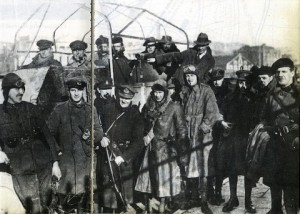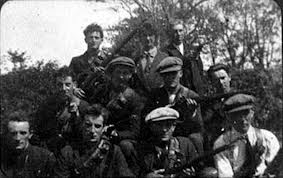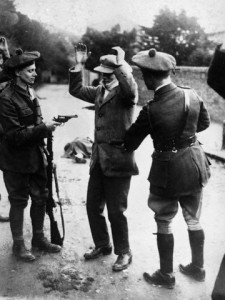The Siege of Tralee, November 1 – 9, 1920.
John Dorney on an ugly cycle of reprisals in Kerry in the War of Independence.
On 31 October 1920, the Sinn Fein Lord Mayor of Cork ,Terence MacSwiney, who had died on hunger strike in protest at what he considered his unlawful detention, was buried in Cork city.
The following day, 1 November, Kevin Barry, an 18-year-old IRA member, was hanged for his role in an arms raid in Dublin that had left three British soldiers dead.
These were two landmark events in the Irish War of Independence – always evoked even now when the conflict is remembered. MacSwiney and Barry were elevated to the status of republican martyrs and presented to the world as examples of British tyranny in Ireland. But their deaths also led indirectly to a week of less well-known bloodshed in county Kerry.
IRA GHQ, based in Dublin, issued orders to units around the country to hit back at anyone in the uniform of the Crown in response to the deaths of MacSwiney and Barry. In some places, County Kildare for instance, the IRA received the orders but just refused to carry them out. They were not prepared to shoot down local policemen with whom they still had a working relationship[1]. In any case, the orders were rescinded when tempers in Dublin had cooled.
Word of this, however, never reached Kerry, where the following 24 hours would unleash a wave of killings and reprisals.
A wave of shootings
The IRA there had killed four RIC policemen since 1916, and by some counts the first Volunteer casualties since the Easter Rising had occurred there, when two Volunteers were shot dead in a raid on Gortalea RIC barracks in 1918. Still though, up until November 1920, the conflict in Kerry had seen relatively little bloodshed.
The IRA had killed 4 policemen up to November 1920, in 24 hours they shot 16, killing seven
This all changed in the night before Barry’s execution; 16 policemen and one naval radio officer were shot, seven fatally, two more were abducted, beaten and then released.
Four policemen were shot in ones and twos while on routine patrol in Abbeydorney and Ballyduff. Two Black and Tans, seeing local girls in Killorglin were shot dead and two more were wounded in Dingle.[2]

Tom McEllistrim, the leader of the IRA active service unit at BallymacElligot, took five men armed with revolvers to kill, “two Tans – Woods and Turner – in Farranfore R.I.C. Barracks who were giving considerable trouble and terrorising the natives. My I.R.A. Unit decided to get rid of them.”
With the aid of a local spotter they identified two Black and Tans on board a train at Ballybrack. “When we reached this carriage door I pulled the door open and Diggins and I shot the two Tans as they attempted to draw their guns. They were alone in the carriage. We pulled them on to the platform, took their arms, and the five of us travelled on the same train in the direction of Farranfore.”
His squad went on to shoot another policeman in Castleisland and then laid an ambush at Ballyseedy for RIC patrols which they expected to leave Tralee. [3]
In Tralee, two policemen were shot and wounded, while another two, (Patrick Waters, an ‘old RIC’ man from Galway and Ernest Bright, a Black and Tan from London) were abducted and ‘disappeared’. Their bodies were never found but rumour had it that they had been thrown in the local gas furnace, or secretly buried in a local crypt after being shot dead.
From where did the Kerry IRA summon the ferocity to unleash such a wave of ruthless attacks all over the county? For the British forces, their behaviour was, no doubt explained by innate Irish savagery, or perhaps the cowardly but murderous fanaticism of the ‘Shinners’. But other areas saw no such bloodletting in those two days. What was special about Kerry?
The Black and Tans in Kerry
A closer look at prior events in the county gives us some clues. By the summer of 1920, the republican activists of Sinn Fein and the IRA in Kerry had effectively neutralized the machinery of government in the south-western county. The Volunteers, starting to go by the name of the IRA, set up a number of fulltime guerrilla units – Active Service Units or ‘flying columns’.
The Black and Tans had terrorised county Kerry in September and October 1920
An RIC report of August 1920 read, ‘All of the able-bodied men in the region have adopted the most aggressive attitude and have arranged with very short notice to attack on the return journey any police or military transport…. There is hostility to the police everywhere in the county…Almost all local magistrates have resigned their commissions through fear of terrorism, which is rampant…It may be taken for granted that nearly all the young people are Sinn Fein and that a large proportion of the young men are Volunteers. Between them these two organizations are controlling the whole life and action of the county.’[4]
Famously the RIC garrison in Listowell, in the north of the county mutinied rather than carry out instructions to shoot any republican suspects who failed to stop after a shouted warning.
To replace them the remaining constables were supplemented by paramilitary police from Britain, the Black and Tans, recruits drawn from demobilised ex-soldiers, drafted into the police and the Auxiliary Division, a specially raised counter-insurgency militia. A substantial number of regular British Army troops were also deployed to Kerry. These forces, but especially the paramilitary police, proceeded to terrorise the county in the late summer and early autumn of 1920.
In Lixnaw in late September, all the local men were taken from a Catholic Church during local Mass and searched. At Abbeydorney the Crown forces burned the local creamery and beat its manager with rifle butts. In Tralee they threw a hand grenade into the family home of two prominent Sinn Feiners, which, though it exploded did not injure the only occupant, the republican brothers’ mother.[5]
In Lixnaw on 25 October a patrol of masked police, exacting retribution for the republicans’ cutting the hair of a local woman who was friendly to the police, publicly stripped two young men naked and beat them before cutting off their sister’s hair and, as at Abbeydorney, setting fire to the local creamery.[6]
The burning of creamery sounds like a rather mild form of repression, but in fact it was one of the worst forms of collective punishment possible in rural Ireland. Creameries were cooperatives where the local dairy farmers would deposit their milk for it to be turned into cream and butter and sold on to markets further afield. Not only would a large number of people work at a creamery but much of the local population depended on it for their income and would also have to bear the costs of rebuilding it
In short, destroying the creamery destroyed the livelihoods of hundreds of people. More than that, targeting the cooperatives struck at the small farmers’ economic independence. It also undid the fruits of over a decade of British land reform in Ireland which since 1908 had subsidised farmers to buy their own land. Nothing could have provoked quite so much loathing for the Crown forces.
Looked at in the light of the RIC’s behavior over the previous month in the county, the savage assault on the police on the nights of 31 October to 1 November 1920 in Kerry begins to look less surprising. By the start of November, people were prepared to tolerate the killing of Black and Tans as a justified revenge.
In revenge for the shootings the RIC lashed out in all directions at the civilian population
But of course, policemen, be they regular or paramilitary, British or Irish-born, saw things very differently. The onslaught on their comrades was followed by an orgy of reprisals.
RIC Reprisals
In Killorglin that night, the Black and Tans burned the Sinn Fein Hall, the Temperance Association Hall and the local garage as well as the home of prominent Sinn Feiner. In Ballyduff another party of RIC torched the local creamery and other businesses. [7]

And reprisals could also be lethal. A young member of the Volunteers John Houlihan was dragged out of his parents’ house near Ballyduff and killed with gunshots, bayonets and rifle butts as his parents looked on. In Killorglin, none of the ‘Shinners’ were found at home so a local man with no political ties, Denis O’Sullivan was taken from his house in the town square, shot and fatally wounded.
Two IRA men, John Cantillon and Michael Brosnan, were shot dead in the nearby village of Ardert and two more civilians were killed there by the end of the week by crown forces (Archer and Maguire). [8]
In Dingle many locals fled the town for the hills or their fishing boats in the harbour in fear of reprisals.
In Ballylongford, two unarmed RIC men James Coughlan and William Muir, had been abducted by the local IRA. The local Crown forces, a mixture of ‘old ‘ RIC and Black and Tans let it be known that, “They would raze Ballylongford to the ground if the two policemen were not released within 48 hours”.
The two were eventually returned, horribly beaten. Coughlan was blindfolded, put in a truck and then driven to a field, he thought to his execution, but in fact was released and told he had a 20 minute walk back to Ballylongford barracks. Muir, the other kidnapped policeman, later that month took his own life. [9]
The Siege of Tralee
It was Tralee however, a town of some 10,000 people, saw the worst of the RIC’s retaliation. In the hours after the first shootings of policemen in the town, three civilians were shot, one fatally. Then two more policemen went missing. In Ballylongford, police threats had apparently secured the return of two kidnapped policemen. The RIC in Tralee tried to do likewise to rescue their two colleagues, Bright and Waters, who had vanished on the night of 31 October.
The RIC in Tralee warned, ‘Unless the two Tralee policemen in Sinn Fein custody are returned before 10 am on the 2nd [November 1920] reprisals of a nature not yet heard of in Ireland will take place in Tralee and its surroundings’[10]. By then though, the RIC men were already dead, shot and their bodies secretly disposed of.
The ‘Tans’ brought Tralee close to starvation in an effort to force the IRA to release two missing policemen – they were in fact already dead
The following day, Monday 1 November, was All Saints Day and the RIC fired at crowds leaving Mass in Tralee. A French journalist on the spot wrote, ‘Volley after volley resounded to the terror of the people’. ‘I do not remember, even in the [First World] War, having seen people as profoundly terrified as those of this small town, Tralee.’ [11]
For the next seven days, ‘the Tans’, as they were known locally, made all the local businesses shut their doors and allowed no food in or out of the town. They imposed a strict curfew and shot people who appeared on the streets. Their victims included two dead, Tommy Wall and John Conway. They also systematically burned any businesses they could link to ‘Sinn Feiners’. By the end of the week, the international press, many of whose organs had correspondents covering the conflict in Ireland and who had come to Tralee, was reporting that the town was on the very verge of starvation.
The regular British Army, whose officers tended to disapprove of police reprisals, by all accounts was the only body that saved Tralee from worse destruction.
Some pressmen had some sympathy for the Black and Tans’ situation, having seen dozens of their comrades shot and fearing their own assassination at any moment, but many others, particularly those from continental Europe and North America, did not. In Ireland itself, the Freeman’s Journal, an organ of moderate nationalism screamed that, ‘A War on Women and Children’ was taking place in Tralee.
By 9 November orders came from Hamar Greenwood, the Chief Secretary for Ireland, that the ‘siege ofTralee’ was to be lifted.
Such reprisals were no doubt relatively mild by the standards of colonial wars along the distant borders of the British Empire, but Ireland was an integral part of the United Kingdom. It was just beside Britain itself and its inhabitants had white skins and spoke English. The publicity in short was highly embarrassing to the British government.
The actions of Crown forces in late 1920 helped to discredit British rule in most of Ireland
The PR disaster that such tactics represented was only compounded by the staging of, the ‘Battle of Tralee’ where Auxiliaries had supposedly routed an IRA flying column and inflicted many deaths in combat on 12 November. In fact, they had shot dead two Volunteers in Kerry (who had been attempting to prevent the burning of the creamery at Ballydwyer) but in the leafy and largely unionist suburb of Dalkey in Dublin, had the filmed a mock ‘battle’ for photographers and news reels. The hoax was easily and gleefully exposed in republican propaganda. [12]
Events in Kerry in the first week of November 1920 brought little credit to any of the participants. It was a particularly dark and dismal form of warfare. The Kerry IRA had ruthlessly targeted dozens of policemen for assassination, many of them unarmed and defenceless. The ‘forces of order’ responded by lashing out at the population at large and shooting dead at least eight people (they were unconfirmed rumours of seven more) who may or may not have been republican activists. By the time of the truce in July 1921, 136 people had been killed in county Kerry.[13]
It is a pattern that is by now more than predictable in conflicts of this type – action – reprisal -polarisation -action. But more than any other single factor it was the actions of British forces in places such as Kerry that finally discredited British rule most of Ireland.
References
[1] Annie Ryan, Comrades, p203
[2] T Ryle Dwyer, The Squad, P156-157)
[3] Tom McEllistrim, Witness Statement Bureau of Military History no. 882
[4] T Ryle Dwyer, Tans Terror and Troubles, Kerry’s Real Fighting Story 1913-23, p219-220
[5] Dwyer, Tans, Terror and Troubles, p220
[6] D.M Leeson, The Black and Tans, P176-177
[7] Dwyer, Squad, p156, 157
[8] Dwyer, Tans, Terror, pp. 229, 242
[9] Ibid. P 230-239
[10] Ibid. p232
[11] Dwyer, The Squad p161
[12] McEllstrim BMH Witness Statement no 882, Michale Hopkinson, The Irish War of Independence p126
[13] Eunan O’Halpin, Counting Terror, in Terror inIreland, p152